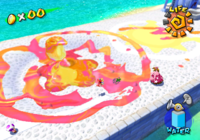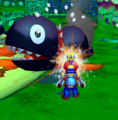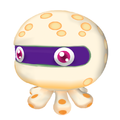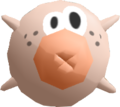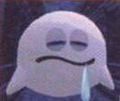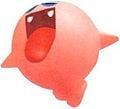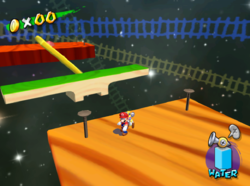Super Mario Sunshine
- This article is about the Nintendo GameCube game. For the WarioWare: Smooth Moves microgame based on this game, see Super Mario Sunshine (microgame).
Template:Infobox Super Mario Sunshine is a Mario action-adventure 3D platformer released for the Nintendo GameCube. It follows Super Mario 64, and is the second 3D Mario platformer. This game introduced many recurring characters and bosses in the Mario series, including Toadsworth, Bowser Jr., Petey Piranha, Gooper Blooper, Piantas, Nokis, Shadow Mario, and F.L.U.D.D. Super Mario Sunshine is the second game in the Mario series to feature extensive voice acting, the first being Hotel Mario, making it the first, and thus far, the only 3D Mario game with said voice acting. It also pays homage to Mario's Italian heritage and upbringing, with many of the locations in the game (including the island itself) having Italian names and sometimes referencing Italian culture.
Story
The game starts off in the Toad Express, where Mario, Princess Peach, a few Toads, and Toadsworth are flying out to Isle Delfino for a vacation. While watching a video advertisement showing its numerous attractions, Peach notices a Mario-shaped shadow figure jumping around in the background. Mario and Toadsworth don't notice this, as they dream about the food and having a good time.
They make a rough landing on Delfino Airstrip, as a large amount of strange, moving goop in the shape of Mario's head is blocking the runway and has formed a pit. Mario goes on a brief search for something to assist him and soon finds a unique water pump invented by Professor E. Gadd named F.L.U.D.D., the Flash Liquidizer Ultra Dousing Device. The machine scans Mario and identifies him as its customer. After user instruction, Mario uses F.L.U.D.D. to clean the goop and defeat a Polluted Piranha after which the runway returns to its normal condition, and a Shine Sprite appears, which Mario collects.
After collecting the Shine Sprite, however, a pair of Pianta Police officers arrest Mario. In court, the prosecution reveals that the island is covered with similar goop, and the graffiti has forced all the Shine Sprites to flee. Eyewitness accounts indicate that Mario is the guilty party, and despite Princess Peach's attempted objection, Mario is found guilty and is ordered not to leave until the entire island is cleaned.
After defeating another Polluted Piranha, the Grand Pianta Statue comes out of the ground with the mysterious character resembling Mario on top. This Shadow Mario attempts to kidnap Peach, but Mario foils his plan and he escapes into the Rainbow M he paints on the base of the statue. This allows Mario to access Bianco Hills and recover more Shine Sprites. Later, similar incidents of various landmarks disappearing in goop happen around Delfino Plaza, and cleaning the goop reveals that these places also have portals to different areas of Isle Delfino.

Once Mario recovers ten Shine Sprites, Shadow Mario kidnaps Peach again and flees to Pinna Park. Mario chases Shadow Mario there and takes down his weapon, Mecha-Bowser. Shadow Mario comes out of Mecha-Bowser's head and reveals himself to be Bowser Jr., Bowser's son. He says that Bowser told him Peach is his mother who got kidnapped by a bad guy named Mario. He also reveals the graffiti to be the work of his magic brush, which he claims was given to him by "a strange old man in a white coat". Bowser Jr. then takes Peach to Corona Mountain by flying in Mecha-Bowser's head. Unable to rescue Peach, Mario returns to cleaning up and recovering Shine Sprites. He also finds Yoshi and new Nozzles for F.L.U.D.D. to use, and unlocks more areas of Isle Delfino to explore. In Episode 7 of these areas, Mario must chase down Shadow Mario to obtain a Shine Sprite from him. When these episodes are cleared, Delfino Plaza is suddenly flooded after a surge of water came gushing out of the cave behind the Shine Gate. This flood also wound up destroying the barrier obstructing the cave entrance, allowing Mario access into Corona Mountain. Working his way to the top of the volcano, Mario finds Bowser and Bowser Jr. relaxing in a huge hot tub of sludge with Peach with them. Mario then battles Bowser and Bowser Jr. by using Rocket Nozzle and then Ground Pounding from high up onto the five platforms protruding from the tub while avoiding Bowser and Bowser Jr.'s attacks. The force of the Ground Pound on the last platform flips the tub end-over-end and everyone plummets down out of Corona Mountain, while a large Shine Sprite hidden in the pool flies out.

Bowser, Bowser Jr., Mario, and Peach fall from the sky, Mario landed head-first onto an island just west of Delfino Plaza, while Peach is floating down with her umbrella and lands softly on the same island Mario has landed on. However, their reunion is cut short when they see F.L.U.D.D. malfunctioning. After looking at Mario giving its last words, F.L.U.D.D shuts down. The Shine Sprite from the hot tub returns to the Shine Gate as the residents of Isle Delfino apologize to Mario for falsely accusing him. Far away from the island, Bowser and Bowser Jr. (who landed on a raft) watch the celebration from the raft. Bowser Jr. says he knew all along that Peach wasn't really his mother, but wants to fight Mario again. Bowser praises his son and says that they rest a while. Later on, as Mario and Peach enjoy a sunset at Sirena Beach, they notice the Toads carrying F.L.U.D.D., which is okay and states, "The vacation starts now!" Pictures of their vacation are shown during the credits, showing Mario and his friends enjoying the island and its wonders. After the credits, a picture of Il Piantissimo discovering the Magic Paintbrush in the sands of Gelato Beach is shown, along with "The End" displayed in the lower right hand corner. However, defeating Bowser after collecting all 120 of the Shine Sprites replaces this picture with a group picture of friendly characters in the game posing in Hotel Delfino, with the the phrase "Have a relaxing vacation!" on the bottom.
Gameplay

Super Mario Sunshine is a 3D platformer where players control the environment around them in a similar manner to its predecessor, Super Mario 64. As with all 3D platformers, players can adjust the camera to their liking. Due to closer objects obstructing features on the level, when certain characters and items are obscured by minor objects such as walls or trees, their silhouettes are marked by a big '?'. This does not apply to Mario and his F.L.U.D.D., to differentiate him from the features.
Super Mario Sunshine is the first game where Mario extensively uses an accessory to complete his mission. F.L.U.D.D. (Flash Liquidizer Ultra Dousing Device) features spray and hovering capabilities when it is first acquired; other nozzles can be unlocked to extend F.L.U.D.D's functionality, such as the "Rocket Nozzle" which propels Mario high into the air, and the "Turbo Nozzle" that lets Mario sprint on land and water, as well as break down wooden doors.
The game contains a number of independent levels which can be reached from Delfino Plaza. Gameplay is based around collecting Shine Sprites by completing various tasks in the levels and over world, very similar to Super Mario 64, but with Shine Sprites instead of Power Stars. However, unlike in Super Mario 64 where the player could usually get most Power Stars no matter which mission was chosen, this game usually lets Mario obtain only the Shine Sprite the player selects from the screen prior to the level.
There are 120 Shine Sprites and 240 blue coins in the game. Ten blue coins can be exchanged for a Shine Sprite at the Boathouse in Delfino Plaza. There are two Shine Sprites at the Airstrip, seventeen in the plaza (including one for collecting 100 coins and one in Corona Mountain), and 11 in each of the seven other areas (eight from main episodes, two hidden, and one for getting 100 coins). There are 30 blue coins in each of the seven areas, making 210, there are 19 in the plaza, one in the Airstrip, and ten in Corona Mountain, making 240 altogether.
At first, each of the seven areas features one task which may be completed to acquire a Shine Sprite. The player is then returned to Delfino Plaza and a new task is unlocked in the area they just played. Each area consists of up to eight of these tasks, as well as two hidden tasks, which may be played again at will once they are completed. Once the player has collected enough Shines in total, a new level is available at Delfino Plaza, either by the acquisition of a new ability or some plot-related event, such as Shadow Mario appearing in the Plaza.
Gameplay proceeds in this fashion until all of Shadow Mario's related missions are completed (the seventh mission of each level), which unlocks Corona Mountain, containing the final boss. As the total number of Shine Sprites available to obtain at any given point is greater than the number of Shine Sprites needed to unlock the next area, players may choose which tasks they want to attempt.
Mario can also ride Yoshis in this game, making Super Mario Sunshine the first 3-D Mario game to incorporate this functionality, being followed by Super Mario Galaxy 2. Yoshis can be used to eat enemies, as well as certain insects and birds that can produce Gold, Blue, or Red Coins, and even Shine Sprites in a few cases. Yoshis can also eat fruit and squirt the juice of the color of that fruit, just like F.L.U.D.D sprays water. This juice can be used to dissolve certain kinds of pulsating goop acting as obstacles, as well as to briefly transform enemies into platforms for Mario to step on. The color of the Yoshi, as well as the effect of its juice, depends on the type of fruit last eaten. However, Mario can't take Yoshi with him when he accesses a new area, meaning that Yoshi is only usable in certain areas and certain missions, and if Yoshi runs out of juice or touches deep water he will vanish, requiring Mario to find the egg and hatch it again.
Koji Kondo and Shinobu Tanaka produced the music for this game.
Controls
 : Move
: Move : Rotate Camera
: Rotate Camera : Look around
: Look around : Jump, hold for Flutter Jump (when on Yoshi)
: Jump, hold for Flutter Jump (when on Yoshi) : Switch Nozzle, Dismount (when on Yoshi)
: Switch Nozzle, Dismount (when on Yoshi) : Menu Guide
: Menu Guide : Dive (in midair), Pick up Fruit, Talk to characters, Hang loose (when on a rope)
: Dive (in midair), Pick up Fruit, Talk to characters, Hang loose (when on a rope) : Set the camera behind Mario, Ground Pound (in midair)
: Set the camera behind Mario, Ground Pound (in midair) : Use F.L.U.D.D., Spit Yoshi Juice (when on Yoshi)
: Use F.L.U.D.D., Spit Yoshi Juice (when on Yoshi) (when sliding on a wall): Wall Jump
(when sliding on a wall): Wall Jump +
+  (jump once touching the ground): Double Jump
(jump once touching the ground): Double Jump +
+  +
+  (jump once touching the ground, full speed): Triple Jump
(jump once touching the ground, full speed): Triple Jump then
then  : Backwards Somersault
: Backwards Somersault then
then  (Opposite Direction) +
(Opposite Direction) +  : Side Somersault
: Side Somersault +
+  : Large range spray
: Large range spray (rotate) +
(rotate) +  : Spinning spray
: Spinning spray (rotate) +
(rotate) +  : Spin Jump
: Spin Jump (rotate) +
(rotate) +  +
+  : Spinning Spray Jump
: Spinning Spray Jump
Enemies
New enemies
- Cataquack.jpg
- Electro-Koopa.png
- Electrokoopa.jpg
- GIANT STU.PNG
- SMS ScuttleBug.JPG
- Plungelo.png
- PokeySproutSMS.png
- SMS Seedy Pod.PNG
- SMS Smolderin' Stu.png
- Snooze-A-Koopa.jpg
- Strollin' Stu.png
- Soarinstu.png
Returning enemies
- Blooperghoul.png
- Booshine.jpeg
- MissileBill SMS.png
- Bulletsunshine.JPG
- Cheep-Cheep Sunshine Art.png
- Spiky Ring.PNG
Bosses
- Polluted Piranha, huge Piranha Plants made out of sludge. Defeated by simply squirting water into their open mouths. They appear once in both Delfino Airstrip and Bianco Hills and a total of three times in Delfino Plaza.
- Petey Piranha, who appears in two of the episodes of Bianco Hills.
- Gooper Blooper, who appears in two of Ricco Harbor's episodes and one of Noki Bay's.
- Plungelos, six of which appear in Gelato Beach.
- Wiggler, who resides on Gelato Beach as the boss of the third mission, angry at Mario for disturbing his nap.
- Mecha-Bowser, a giant mechanical version of Bowser that is controlled by Bowser Jr. Appears only in the first episode of Pinna Park.
- Monty Mole, who shows up in two levels, both times arming a large, triple-gun cannon that fires Bullet Bills, Bull's-Eye Bills, Bob-ombs, and Glorpedoes.
- Phantamanta, the silhouette of a giant manta ray appearing in Sirena Beach's first episode that splits into smaller manta rays when sprayed by F.L.U.D.D.
- King Boo, who only appears in Sirena Beach's fifth episode.
- Eely-Mouth, who has taken up residence under Noki Bay and is unwittingly poisoning the water with purple sludge due to his teeth being in poor condition.
- Shadow Mario/Bowser Jr., who, despite causing the whole island's issues, is never actually the boss of a level, besides every level's one Shadow Mario chasing mission found in episode seven of every main area.
- Bowser, the final boss of the game, is found sitting in a hot tub full of green sludge floating in the skies of Corona Mountain. Bowser Jr. and Princess Peach are both found in the tub with him.
Locations
Levels and Episodes
Secret levels
Every area in the game has one or two secret levels. These are never part of the regular area and are usually inside an alcove (barred off after defeating the level). These secret levels start with a short cutscene of Mario falling through a white area and Shadow Mario stealing F.L.U.D.D, thus leaving Mario only to rely on his acrobatic skills. These levels can also be revisited, but F.L.U.D.D will be accessible to aid in movement. When revisiting, there is also a red button that, when ground-pounded, makes eight Red Coins appear throughout the level and sets off a timer. The red coins must be collected before the timer runs out or Mario loses a life and has to restart the level. Collecting them results in one of the two hidden Shine Sprites in that area appearing.
These levels feature a cover of the classic "Mario Bros." music (Super Mario Bros. for the NES) in a rhythmic, upbeat, a cappella style accompanied by snapping fingers. Secret levels are staged in an apparently infinite void in which Mario may fall and lose a life. Various platforms and obstacles are found in the level, including the following:
- Red and blue platforms that flip constantly. Mario alternates between red and blue platforms because all the red platforms flip at the same time, followed by all the blue ones.
- Long, square-faced wooden blocks with colored knobs that rotate, so Mario must run along them at an angle while avoiding the pegs or risk falling off. This level was slightly modified and reused in Super Mario Galaxy 2, in the Twisty Trials Galaxy (located in World S).
- Cubes made of glass with white edges that have colored corners that frequently sit at the edge of a platform (or shortly off it). These will carry Mario on the top and move to otherwise-unreachable platforms as they rotate and turn. Mario must walk to the flat edge to keep from falling.
- Blocks made of sand that crumble as Mario steps on them (but regenerate shortly). These are often arranged into a long path or a sand castle that has to be navigated through that is continually breaking apart.
- Blocks that disappear and reappear at regular intervals, regardless if Mario steps on one of them.
- Moving Yoshi Egg patterned blocks in different colors that move in a set path and must be jumped across in order. They move through two archways, one of which stops Mario if he tries to pass through it.
- Orange blocks with no special characteristic other than moving in every direction. They are arranged in large groups.
- Some platforms have nails sticking out of them. If Mario Ground Pounds on them three times they will be completely in the ground and he can get a few coins, a 1-Up Mushroom, or nothing. They are usually on large, stationary platforms.
When losing a life on the secret levels, Mario will restart at the starting point of the level as opposed to returning to Delfino Plaza. If the player runs out of lives, however, he returns to the plaza.
There is also a second, rare type of secret levels, included below. In these secret levels, Mario always has access to F.L.U.D.D. These levels always take place in the sky and have a different background music. One appears in Episode 4 of Gelato Beach, one in Episode 3 of Noki Bay. Secret levels of this type are also available in Delfino Plaza.
Items
- Shine Sprites - When certain totals are achieved, the story progresses.
- F.L.U.D.D. - Helps Mario throughout the game with various abilities.
- Nozzles- Allows Mario to Hover for a short time, blast up in the air, or make him go extremely fast.
- Red Coins - Some levels require all eight Red Coins of the level to be found in order to get the Shine Sprite.
- Blue Coins - Can be traded for Shine Sprites at the Blue Coin Shop.
- 1-Up Mushrooms - Give Mario an extra life.
- Fruit - Food for Yoshis, which refills their Juice Meter.
- Water Bottles - Fill F.L.U.D.D's water tank.
- Mario Cap - Stops Mario from losing health.
- Gold Coins - Mario can collect 50 to get a life, or 100 to get a Shine Sprite.
- Water Barrel - Mario can throw it to clean a large area, as it releases a large burst of water.
- Trampoline - Allow Mario to reach higher areas.
- Water Rockets - Missiles that attach to F.L.U.D.D that can be launched with water.
- Barrel - Objects that Mario can carry and throw at enemies.
Differences from other 3D Mario platformers
- This is the only 3D Mario platformer in which Peach's Castle does not appear, as well as one of three 3D Mario platformers that do not begin with Princess Peach sending Mario a letter (the other two being Super Mario 3D World and Super Mario Odyssey).
- This is one of only two 3D Mario platformers where Princess Peach is not kidnapped at the very beginning of the game, with the other being Super Mario 3D World (where she's not kidnapped at all, as she's one of the playable characters).
- This is also the only 3D Mario platformer that does not include Goombas or Koopa Troopas as enemies. However, Strollin' Stus act very similarly to Goombas, and two subspecies of Koopa Troopa appear in the game (Electro-Koopas and Snooza Koopas).
- This is one of only three 3D platformer games in the Super Mario series not to feature Luigi, the others being Super Mario 64 and Super Mario Odyssey.
- This is the only main Mario game to date not to feature any sort of item that grants temporary invincibility.
- This is the first and only 3D Mario platformer where Mario cannot perform the Long Jump.
- This is the only 3D Mario platformer in which Mario fights against Bowser (or his imposter) only once during the storyline. In most of the others, Mario and Bowser fight three times.
- This is one of only two 3D Mario platformers that have yet to receive a sequel or remake, the other being Super Mario Odyssey.
Regional differences
Cutscenes
Despite cutscenes in the Japanese release using English voice acting, there are a few differences compared to International releases early in the game. Mario's conversation with Toadsworth is audible, with a few unsubtitled remarks. After getting out of the plane, Mario says "It looks like a giant pool of paint"; later in the same cutscene, when Peach notices that Shadow Mario is gone, Mario can be heard saying "Looks like Mario's gonna have to find a job" in the background, to which Toadsworth responds with "Trying to start a new career?" before quickly changing the subject. Soon afterwards, in the court cutscene, the prosecutor uses an alternate take in which he mispronounces "Shine" as "Shrine" three times, refers to "Isle Delfino" as "Delfino Isle", and mispronounces "aware" as "of where" once. His tone is also distinctly different, sounding much less stern.
In addition, there is no option to turn off the subtitles (likely due to it being Japanese, but with English voices).
Location names
The Japanese version has different names for the locations in the game.
- Isle Delfino is called Dolphic Island.
- Delfino Airstrip is simply named Airport.
- Delfino Plaza is named Dolphic Town.
- Gelato Beach is named Mamma Beach.
- Noki Bay is named Mare Bay.
- Pianta Village is named Monte Village.
In cutscenes, the names of Isle Delfino and Delfino Plaza are the same as in the later English localization (as are the characters Bowser, Toadsworth and F.L.U.D.D.), although they are altered in the subtitles.
Other changes
- The "Press Start" on the title screen was moved to the top corners of the logo in the American version, while it is at the bottom of the screen in the Japanese and PAL versions.
- Audio delay (such as when Shadow Mario appears in Delfino Plaza) is removed from the international versions.
- When racing Il Piantissimo in international versions, a unique music theme plays. In the Japanese version, the level theme still plays.
- A small voice clip from Mario when exiting a Rainbow M is absent in the Japanese version.
- If Mario collects his 100th Delfino Plaza coin in the Red Coin Field, the Japanese version locks up because it does not know where to spawn the resulting Shine Sprite. A spawn point was added to international versions and thus the game no longer locks up there.
- The button icons are less generic in international versions and actually resemble GameCube controller buttons.
- The small text on the map screen was rewritten and made thicker.
- When jumping off Yoshi, Mario jumps straight above him in the Japanese version while he dismounts behind him in international versions. This is to fix a glitch where Mario can clip through ceilings by jumping off Yoshi.
- The preview cinematics for Bianco Hills, Ricco Harbor and Gelato Beach were changed in international versions, with the camera generally making wider circles in the Japanese versions. This led to some noticeable jump-cuts in the Bianco Hills preview.
- In Scrubbing Sirena Beach, Mario has to clean 99% of the goop in the Japanese version but only 95% in international versions.[citation needed]
- The small text on signs is in English in the Japanese version and in made-up, unreadable symbols in international versions.
- Fruits were added to Delfino Plaza's fountains in the international versions to make feeding Yoshi easier.
- When losing a life, "Miss!" appears instead of "Too Bad!" in the Japanese version, and when gaining a Shine Sprite, "Shine Get!" appears instead of "Shine!".
- When Yoshi almost runs out of juice before disappearing, the text "Hungry" appears in the Japanese version. In the international versions, it says "Fruit".
- PAL versions have additional differences from all NTSC versions. Only NTSC versions can be played in progressive scan mode, and only PAL versions can be played in 50Hz mode, using the same method to activate each. The American and Japanese versions have their languages locked to English and Japanese, respectively, while the PAL version can additionally be played in Spanish, French, Italian and German depending on the GameCube settings.
Media
- For a complete list of media for this subject, see List of Super Mario Sunshine media.
Gallery
- For this subject's image gallery, see Gallery:Super Mario Sunshine.
- SMS-Mario FLUDD Running.png
Mario spraying water
Mario covered with Graffiti
- Shadow Mario Artwork - Super Mario Sunshine.png
A group of Piantas
- PeachSunshine.PNG
Princess Peach
Reception
It has been requested that this article be rewritten and expanded to include more information. Reason: 17:27, 13 August 2014 (EDT)
Super Mario Sunshine received widespread critical acclaim, currently holding an aggregate score of 91.50% on Gamerankings based on 76 reviews. [1] While praise was directed towards the wide array of moves, criticism was directed towards the camera, the gimmicky nature of F.L.U.D.D. and the Yoshis, and the game's voice acting. Super Mario Sunshine is the 3rd best selling game for the Nintendo GameCube as it sold about 6.3 million copies as of December 31, 2009, and was the 10th best selling game of 2002, according to the NPD. [2]
Pre-release and unused content
In Super Mario Sunshine, Delfino Plaza is the main plaza of the game. However, in trailers before release, it showed that there was going to be a different plaza (or a possible early Delfino Plaza), with a giant Strollin' Stu-like creature called Hinokuri walking around the place and many more different things.
A pre-release video also reveals that humans were intended to be citizens of the plaza. F.L.U.D.D. was going to be skinnier. Gooper Blooper was going to be dark blue and fought on top of the bridges of Ricco Harbor instead of in the market and helicopter area.
- Sunshine Beta.jpg
An unused human citizen of Isle Delfino. - Tramplin' Stu.jpg
A Hinokuri. - Old FLUDD.jpg
F.L.U.D.D.'s old, thinner design. - Gooperbeta.JPG
Gooper Blooper's early design.
Glitches
- Main article: List of Super Mario Sunshine glitches
Blasting through the Wall
The player must first get the Turbo Nozzle in Delfino Plaza and then head to the fruit stands. While standing slightly against the wall behind the papayas and pineapples (Mario's body should touch the wall, but he should not be directly facing it), Mario can blast his Turbo Nozzle, and before reaching the durians, he will go right through it into an underground area. If Mario stops jumping while underneath Delfino Plaza he automatically dies, but it is possible that a glitch will occur within. This glitch which makes Mario lie on the ground as if he were dead, yet he occasionally opens his eyes for a second. If that happens, the player needs to reset the game. It's also possible that Mario might come across an underground pipeline to run into instead of falling under Delfino Plaza.
Game Resets Itself
This glitch can only be done in the Ricco Harbor while playing through the Blooper Surfing Safari level, or in any Pinna Park level that involves entering the amusement park. To perform this glitch in Ricco Harbor, Mario must pick a Blooper from the floating platform. As he navigates himself to the tunnel with the pollution, Mario must enter the tunnel, but only before the screen changes to the Blooper race course inside the tunnel. Just as he enters, the player must pause the game and select, "Exit area." He will then enter the tunnel, but instead of entering the Blooper race course, the game will reset itself. In Pinna Park, Mario must perform a water dive and then pause just before entering the park's loading zone. If done correctly, the game will reset.
Yoshi's Slippery Saddle
To make this glitch occur, Mario must go to Sirena Beach and enter the hotel. Next, he must hop on a Yoshi and enter the attic. If Mario runs into a Sleepy Boo, he flies off the Yoshi, as usual, but if he tries to jump on the Yoshi again, he falls off again. Mario can no longer jump on the Yoshi unless he goes downstairs to get the Yoshi again, Mario jumps on Yoshi and immediately eats the Boo, or if Mario takes damage and then jumps on Yoshi.
Quotes
- Main article: List of Super Mario Sunshine quotes
Bowser
- "Bwa ha ha! The water's great! Eh, Junior?"
- "Mario! How dare you disturb my family vacation?!"
- "Jr., I've got something...difficult...to tell you about Princess Peach..."
- "That's my boy! Well put, son! The royal Koopa line is strong as ever! But for now...let's just rest awhile."
Sunglasses vendor
- "I love the sunshine, but OOOH! Is it ever bright!"
- "Here, little man. Try a pair of my special sun shades. They're cool!"
- "Yeah heh heh... You're styling now!"
- "Come back and talk to me when you don't need them anymore."
- "Hey! Sun shades alone just won't cut it for you. Nope!"
- "You also need one of my custom tropical shirts. Here you go!"
- "My, oh my! I haven't seen anyone look that good in my gear in ages!"
- "Come see me again when you want to return them, OK?"
- "You had enough? Come by anytime if it's too bright for you, OK, little man?"
Staff
- Main article: List of Super Mario Sunshine staff
Executive producer
Producers
Directors
- Yoshiaki Koizumi
- Kenta Usui
Appearances in other media
Super Mario Sunshine has been adapted into numerous comic books. It was the subject of a story arc spanning volumes 28, 29, 30, and 31 of Super Mario-Kun.
Like Super Mario World 2: Yoshi's Island before it, Super Mario Sunshine was made into a manga of the same name as part of the 4-Koma Gag Battle series. The game was also made into a manga published by Futabasha Publishers Ltd. as part of the 4-Koma Manga Kingdom series.
Volume 31 of Super Mario-Kun.
References to other games
- Mario Bros.: When F.L.U.D.D. scans Mario during his malfunction after the fight with Bowser, a black-and-white screenshot from this game is shown with the text "GAME OVER" just before his video crashes.
- Super Mario Bros.: Before the game starts, an 8-bit coin sound effect is played while the Nintendo logo is displayed. Also, covers of the main Super Mario Bros. theme, as well as the underground stage theme, are featured in the game. There's also a stage in Sirena Beach where a giant 8-bit Mario can be seen in the background. Also, at the beginning of the game, it is possible to see three "memories" of Mario in the lower left-hand corner. The first of the three is a NES video of Mario approaching a Bowser Impostor on the iconic bridge (although it could just as easily have been a Disk System recording of Super Mario Bros.: The Lost Levels).
- Super Mario Bros. 3: When the player opens the Z-button guide in Delfino Plaza, the map of Delfino Plaza has the sprite of Mario's head showing his current location.
- Super Mario World: When F.L.U.D.D. scans Mario, the second video shows the SNES boss fight with Iggy Koopa. Also, the ability to climb on gates and punch enemies from the inside of it originated from this game, as well as riding on Yoshi, as well as the added drums in the background music when Yoshi is being ridden on. Finally, the regular boss music is a cover version of the final boss music against Bowser from Super Mario World.
- Super Mario World 2: Yoshi's Island: One of the secret levels in Pinna Park has a background reminiscent of this game.
- Super Mario 64: The number of Shine Sprites in Super Mario Sunshine is the same number of Power Stars in Super Mario 64. Also, the way Mario enters Noki Bay is very similar to the way Mario enters the Tower of the Wing Cap in Super Mario 64. When F.L.U.D.D. scans Mario, the last video is the memorable N64 boss fight with Mario swinging Bowser by the tail. The stage is Bowser in the Dark World. Most of Mario's animations, as well as a few voice clips are reused, while others are new. The player's head can get stuck in sand similar to getting Mario's head getting stuck in the sand or the snow in this game. The music played when Mario and Peach are watching the sunset is a remake of Peach's usual theme when she is rescued.
- Yoshi's Story: The idea of eating fruits to keep Yoshis healthy is similar in this game.
- Luigi's Mansion: F.L.U.D.D. and the Magic Paintbrush are inventions of Professor E. Gadd. During the third episode of Sirena Beach, one of the employees in the hotel claims that the ghosts are annoying and wishes that "Someone would come and suck them away with a vacuum or something" and then asks Mario "Why are you looking at me like that?". When Mario tries to open locked doors in Hotel Delfino, he makes a similar grunt to the noise that Luigi makes in the same situation in this game.
References in later games
- Mario Golf: Toadstool Tour: Many of the enemies' names from this game appear on the scoreboards in Tournament mode, such as Phantamanta, Poink, Cataquack, and Plungelo. The Blooper Bay course also bears a minor resemblance to Gelato Beach. Lastly, this game marks the first time Petey Piranha, Bowser Jr, and Shadow Mario appear as playable characters.
- Mario Kart: Double Dash!!: Shine Sprites were included in this game in the Shine Thief battle mode. The stage Peach Beach resembles Delfino Plaza and contains Cataquacks, and Piantas and Nokis also appeared. Bowser Jr. is a default playable character, and Petey Piranha is also an unlockable pair of characters. Part of the Delfino Plaza theme can be heard during the award ceremony music.
- Mario Golf: Advance Tour: Same as Mario Golf: Toadstool Tour, except for course and playable characters. The item Shine Sprites were included in this game. Also, some of Mushroom Tourney bears a minor resemblance to Bianco Hills.
- Paper Mario: The Thousand-Year Door: Shine Sprites and Piantas made an appearance in this game, but they had an entirely different purpose. Also, Doopliss's parrot will say the phrase, "Shine Get!", which is the phrase that appears after Mario gets a Shine Sprite in the Japanese version of Super Mario Sunshine.
- Mario Power Tennis: The court Delfino Plaza comes from this game and the Gooper Blooper Court takes place in Ricco Harbor. Also Mecha-Bowser, Bowser Jr. and Petey Piranha reappear in this game.
- Super Mario 64 DS: A new beach stage called the Sunshine Isles plays a version of the Delfino Plaza music in the background. The acapella cover of the Super Mario Bros. theme from the secret levels appears in this game can also be heard in two of Mario's mini games. A version of the Hotel Delfino casino theme plays during Luigi's casino minigames, only with the whistling and saxophones removed.
- Mario Superstar Baseball: One of Mario's team names is the Mario Sunshines, referencing this game.
- Mario Kart DS: A new stage was named Delfino Square in reference to Delfino Plaza. Also, there is a battle mode, Shine Runners, where the player has to collect the most Shine Sprites in the time given.
- Mario & Luigi: Partners in Time: The Shine Sprites make an appearance in this game. The Mario Bros. have to hit them to get some light for a limited time in dark areas where the Baby Bros. go. Also, Petey Piranha appears as a boss in the game.
- New Super Mario Bros.: The minigame Trampoline Time has the same music as the secret levels in Super Mario Sunshine and Bowser Jr. is the second antagonist again.
- Super Paper Mario: A Sammer Guy exists who calls himself "Sunshine Flood".
- Super Mario Galaxy: Fire Cannons and Water Shooters, which appear in various galaxies, appear very similar to F.L.U.D.D.'s nozzle. Also, Cataquacks make a few appearances as helpful enemies to get Power Stars. A toy robot-like Bowser is called Mecha-Bowser as a reference to the Pinna Park boss.
- Super Smash Bros. Brawl: Mario could use F.L.U.D.D. in this game to spray his opponents. Also, Delfino Plaza appears as a selectable stage. The themes for Delfino Plaza and Ricco Harbor appear as selectable music for the aforementioned stage. Petey Piranha is the first boss in the Adventure Mode. Several stickers and trophies are of characters who debuted in this game.
- Mario Kart Wii: The race course Coconut Mall as well as the battle course Delfino Pier, which are references to Super Mario Sunshine, appear in this game. Piantas and Nokis can also be seen watching the racers.
- Mario & Luigi: Bowser's Inside Story: A Shine Sprite appears in this game as one of the ranks for Mario and Luigi.
- Super Mario Galaxy 2: The Starshine Beach Galaxy is based on the motifs of Sunshine, such as the Grand Pianta Statue, and makes several references to the game. Piantas return as non-playable characters in said galaxy. In addition, the Twisty Trials Galaxy is based almost-exactly on the Secret of Ricco Tower level.
- Super Mario 3D Land: Tightropes are featured as a game mechanic similar to this game's ropes. The cutscene with Bowser and Mario before the final boss fight mimics the cutscene before the first Petey Piranha fight, with the floor cracking, Mario and Bowser looking around, and falling into the battle area after the floor collapses.
- Mario Kart 7: As Piantas are removed entirely on any Mario Kart: Double Dash!! retro track in Mario Kart 7, the only reference that exists of Super Mario Sunshine is a single advertisement board at the side of Dino Dino Jungle, displaying the words "Sunshine Parts" with a Shine Sprite as the background. This is because Dino Dino Jungle appears as a retro track from Mario Kart: Double Dash!! in the game. Wii Coconut Mall also reappears but with the physical Piantas removed as well, leaving only the ones in the logos to appear.
- Paper Mario: Sticker Star: One of the questions in "Snifit or Whiffit" is "Bowser is Bowser Jr.'s Dad, and Princess Peach is his mother", which might be a reference to this game. Also, Gooper Blooper appears as the World 3 boss. Lastly, Petey Piranha's belly button is once again his weakness.
- Mario Kart 8: Sunshine Airport has a Shine Sprite for its logo, and it takes place on a tropical island. The European release date for this game (Oct 4th, 2002) is used as a serial number on some storage crates (55402MS).
- Mario Kart 8 Deluxe: Shine Sprites appear again in the Shine Thief battle mode.
- Super Smash Bros. for Nintendo 3DS / Wii U: Delfino Plaza reappears as a Past Stage in the Wii U version of this game as well as the two themes used in the stage: Delfino Plaza and Ricco Harbor. Shadow Mario and the Magic Paintbrush appear as part of Bowser Jr. and the Koopaling’s Final Smash Shadow Mario Paint.
- Paper Mario: Color Splash: There is a character called Petea Piranha that looks and attacks exactly like Petey Piranha.
Names in other languages
| Language | Name | Meaning | Notes |
|---|---|---|---|
| Japanese | スーパーマリオサンシャイン[?] Sūpā Mario Sanshain |
Super Mario Sunshine | |
| Chinese | 超级马力欧 太阳之光(Simplified)[?] | - | |
| Korean | 슈퍼 마리오 선샤인[?] Shupeo Mario Seonshain |
Super Mario Sunshine |
Trivia
- Sometimes, when losing a life, Mario will say "Arrivederci" which is Italian for "Goodbye". In the German translation, the words "Too bad" will display as "Arrivederci".
- According to the Encyclopedia Super Mario Bros., all the enemies and even the Yoshis of the game are derived from the scribbling of Bowser Jr., hence their weakness to water, as well as the slightly different appearance of enemies.[3]
- The shine on the boxart of the North American, Japanese, and UK English versions of this game roughly says, “Mario has more moves than ever, you’ll have to master them all to sprinkle water in the Sunshine“. All the other European boxarts have this sentence as well, but translated.
References
- ^ Super Mario Sunshine for GameCube- GameRankings. Retrieved October 21st, 2015
- ^ NPD Press Release- January 28, 2003(January 28, 2003). Retrieved October 21st, 2015
- ^ Template:Media link. The title of the box is 「クッパJr.の落書き!」 which means The graffiti of Bowser Jr.! and the text says 「本作の敵キャラクターたちは、クッパJr.が落書きで生み出したという設定。そのため、水に弱かったり、デザインが他のシリーズと少々異なっていたりする。ヨッシーも、同様の理由で水に落ちると消えてしまう。」 which means This game's enemy characters are created by Bowser Jr.'s scribbling. That is why they are weak to water, and differ slightly in design from the rest of the series. Yoshi also vanishes if he falls in water for the same reason..
